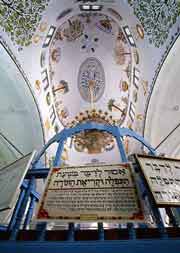Rabbi Yitzhak Abuhav was a Spanish Kabbalist who never visited Tsfat. He taught Jewish ethics, knowledge, and belief. He served in the rabbinate in Toledo and headed a yeshiva there. Among his more famous students was Rabbi Yaakov Beirav. After their expulsion from Spain, Jewish exiles arrived in Palestine carrying a Torah scroll scribed by Abuhav. Tradition claims that Abuhav designed a synagogue while in Spain, incorporating kabbalistic symbols into the design, which served as the building plan for the synagogue named for him in Tsfat. In accordance with Kabbalah tradition, the design of the synagogue has numerical significance: one bimah, two steps to it, three Arks, and so forth. The synagogue’s bimah is located in the center with benches surrounding and facing it. The southern wall contains the three Arks. The center Ark contains Torah scrolls used on a regular basis. The Ark on the left serves as a depository for old and worn out texts. The Ark on the right contains two significant Torah scrolls. One is the Torah scroll Abuhav penned that is the oldest in Tsfat. It is only used three times a year: Rosh Hashanah, Yom Kippur, and Shavuot. The Ark on the right also contains a Torah scroll penned by Rabbi Solomon Ohana, a Kabbalist from Morocco who moved to Tsfat in the 16th century, around the time when the synagogue was built. The earthquakes of 1759 and 1837 leveled the entire synagogue except for the southern wall containing the Arks. To this day, the southern wall is the only remnant of the original synagogue. The domed interior of the synagogue is decorated with depictions of musical instruments that were used by the Levite choir in the Temple in Jerusalem, symbols of the tribes of Israel, and four crowns refered to in a Mishnaic teaching: the crown of kingship, the crown of priesthood, the crown of Torah, and the crown of a good name, which surpasses all the three others. There is a fifth crown not mentioned in the Talmud that is “the crown of impending redemption,” a reprise of the dominant theme of 16th century Tsfat: a belief in the imminent arrival of the messiah. A painting of the Dome of the Rock, the mosque built on the site of King Solomon’s Temple, is visible from the synagogue’s entrance. According to tradition, the Temple was destroyed because of causeless hatred between Jews. The artist painted the Dome of the Rock to remind Jews that the Temple will be rebuilt when there is love and tolerance among Jews. Elijah’s chair sits facing the bimah and is only used during brit milot (male covenant ceremonies). A small wooden basin attached to Elijah’s chair is for the baby. Above the chair is a silver memorial plaque to honor the six million Jews killed in the Holocaust. Sources: Ascent of Safed, Experience Tsfat, Israel in Photos, Safed, Safed and the Abuhav Synagogue ; Photo courtesy of HaChayim HaYehudim Jewish Photo Library (Jono David Media) |
